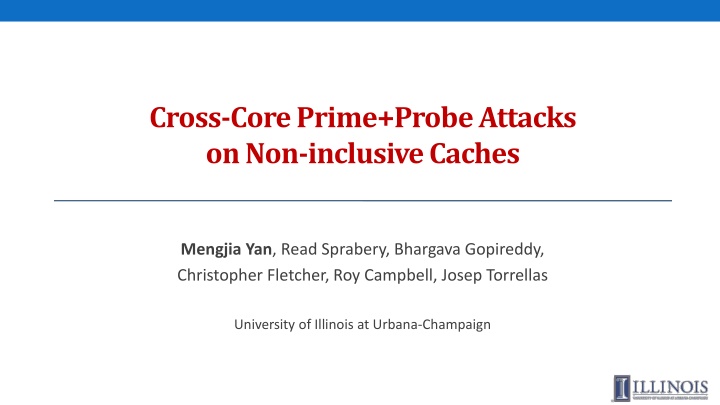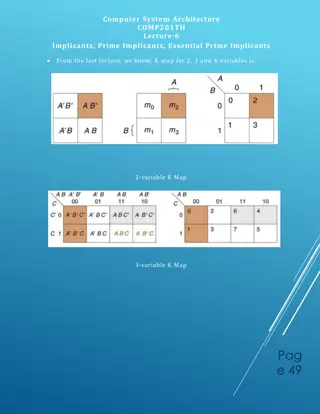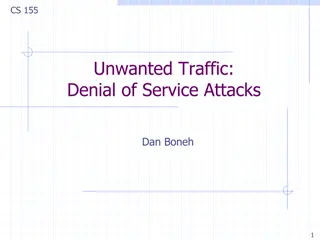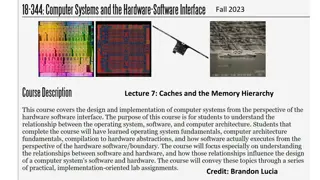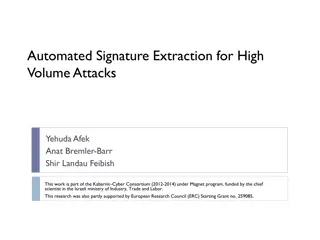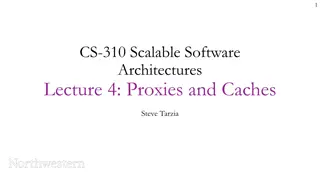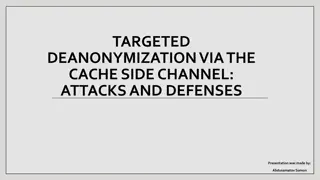Cross-Core Prime+Probe Attacks on Non-inclusive Caches: Modern Challenges and Solutions
Modern systems are transitioning to non-inclusive cache hierarchies, presenting new challenges for cache attacks. This study delves into the complexities of Prime+Probe attacks on non-inclusive caches, highlighting the difficulties in eviction set construction and the need for innovative strategies to target sliced non-inclusive LLCs. The research uncovers insights into directory structures, reverse engineering Intel Skylake-X processors, and designing effective attack methods, marking a significant advancement in cache security.
Uploaded on Feb 15, 2025 | 4 Views
Download Presentation

Please find below an Image/Link to download the presentation.
The content on the website is provided AS IS for your information and personal use only. It may not be sold, licensed, or shared on other websites without obtaining consent from the author.If you encounter any issues during the download, it is possible that the publisher has removed the file from their server.
You are allowed to download the files provided on this website for personal or commercial use, subject to the condition that they are used lawfully. All files are the property of their respective owners.
The content on the website is provided AS IS for your information and personal use only. It may not be sold, licensed, or shared on other websites without obtaining consent from the author.
E N D
Presentation Transcript
Cross-Core Prime+Probe Attacks on Non-inclusive Caches Mengjia Yan, Read Sprabery, Bhargava Gopireddy, Christopher Fletcher, Roy Campbell, Josep Torrellas University of Illinois at Urbana-Champaign
2 Modern Cache Hierarchies Modern systems are moving to non-inclusive cache hierarchies Latest Intel server processor uses non-inclusive caches LLC Slice 0 LLC Slice 4 Skylake-S (Sep 2015) Skylake-X/Skylake-SP (Jun 2017) Core 0 Core 4 LLC Slice 1 LLC Slice 5 Core 1 Core 5 256KB/core 16-way, inclusive 1MB/core 16-way, inclusive L2 LLC Slice 2 LLC Slice 6 Core 2 Core 6 2MB/core 16-way, inclusive 1.375MB/core 11-way, non-inclusive LLC Slice 3 LLC Slice 7 LLC Core 3 Core 7 Existing conflict-based attacks do not work on sliced non-inclusive caches
3 Challenges of Prime+Probe Attacks Lack of Visibility into the Victim s Private Cache target address eviction addresses victim cache 0 victim cache 0 attacker cache 1 attacker cache 1 evict an inclusion victim private caches Victim s line duplicates in L1 and L2 Victim s line does not exist in L2 shared cache eviction set (EV) insert to LLC. No conflict No inclusion victim insert to LLC. cache conflict. (b) non-inclusive cache (a) inclusive cache
4 Challenges of Prime+Probe Attacks Eviction Set Construction is Hard target address eviction address private caches also insert to private cache evict to shared cache insert to shared cache private cache slice 1 slice 0 slice 1 slice 0 both evict to DRAM insert to shared cache Need LLC conflicts on the target slice to further evict the target line. (b) non-inclusive cache (a) inclusive cache Eviction is affected by the replacement policies in multiple caches, and address slice distributions. Eviction is only determined by the LLC replacement policy.
5 Contributions 1) We develop an algorithm to create Eviction Set on sliced non-inclusive caches. 2) We reverse engineer the directory structure in Intel Skylake-X processors. Previous attacks on inclusive caches are an example of directory attack. 3) We identify that directory as a unified structure to bootstrap conflict-based cache attacks for different cache hierarchies. 4) Based on our insights into the directory, we design the first Prime+Probe attack on sliced non-inclusive LLCs.
6 The Inclusive Directory Structure Insight: Directory must be inclusive to maintain tracking information for all the cache lines resident in the cache hierarchies. directory entry for lines in LLC directory entry for lines in L2 but not LLC Attack opportunity analysis: LLC Slice ???= 12 <??2= 16 Cache Lines Directory and Tags Due to the associativity difference, we can create ED conflicts. Can ED conflicts lead to inclusion victims? Traditional Directory Extended Directory The new attack surface! (ED)
7 Creating Inclusion Victims via ED Conflicts attacker core 1 directory entry victim core 0 cache line target address L2 evict the target line from remote L2 to LLC probe addresses directories cache lines traditional directory inclusion victim LLC slice extended Directory (ED) Prime: access ???probe lines to occupy the target set in a ED slice insert into L2 and ED. ED conflict.
8 Prime+Probe Attacks Targeting the Directory attacker core 1 directory entry victim core 0 cache line target address L2 probe addresses directories cache lines Prime: access ???probe lines to occupy the target set in a ED slice Wait: wait for the victim to perform an access Probe: re-access the ???probe lines and measure access latency traditional directory LLC slice extended Directory (ED) victim does not perform access Probe latency is short
9 Prime+Probe Attacks Targeting the Directory attacker core 1 directory entry victim core 0 cache line target address L2 victim accesses target line probe addresses directories cache lines Prime: access ???probe lines to occupy the target set in a ED slice Wait: wait for the victim to perform an access Probe: re-access the ???probe lines and measure access latency traditional directory LLC slice extended Directory (ED) directory entry migration. ED conflict. Victim performs access Probe latency is higher
10 Conclusion Directory = The unified structure for conflict-based cache attacks Attack Directories, Not Caches: Side-Channel Attacks in a Non-Inclusive World recently accepted in IEEE Symposium on Security and Privacy (SP 19). More in the Paper Eviction set construction algorithm. Steps of reverse engineering the directory structure. Root cause analysis of the the vulnerability A multi-threaded high-bandwidth Evict+Reload attack. Attack results on AMD machines.
